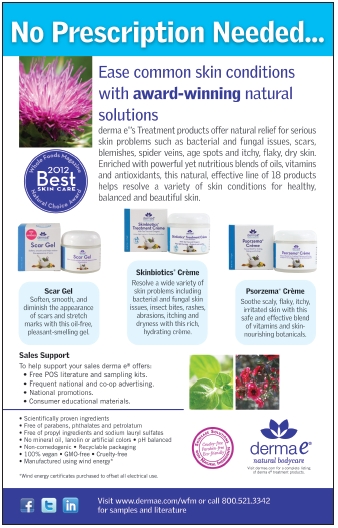When it comes to the biggest organ in our bodies, shoppers should know how to keep their skin naturally hydrated and healthy. Here, we pinpoint seven impressive ingredients that may not be familiar to everyone, but will ultimately help moisturize the one organ that people actually see.
It’s All About the Oils!
The first, cupuacu oil, has large amounts of phytosterols, which increase water absorption. It also has among the highest levels of essential fatty acids of any fruit or vegetable. Fatty acids are crucial to the skin’s softness and elasticity.
The flavonoid quercetin found in cupuacu preserves vitamin C, a powerful antioxidant that also keeps the skin soft and moisturized. Vitamin C is crucial to the foundation of all cell growth and renewal. Constant cell replacement is the key to healthy skin. Vitamin C is a water-soluble vitamin, which means it absorbs into skin easily. Stress, infection and lack of sleep use up a lot of vitamin C. Replenishing this vitamin topically can be beneficial to healthy skin (1). Sometimes, companies combine vitamin C ingredients with hyaluronic acid (dubbed the moisture magnet), which is often used for plumping and moisturizing since it attracts and retains water.
Jojoba oil, though not as unfamiliar as cupuacu, is also an  ingredient in moisturizers that newcomers to holistic beauty care may not have encountered. It is a mixture of long-chain monounsaturated liquid wax esters. Unlike many other oils, jojoba oil does not contain triglycerides, which are made of fatty acids and glycerol. It is structurally and chemically similar to human sebum. Sebum is produced by the sebaceous gland, and is an oily/waxy matter that lubricates the skin, found mostly in the face and scalp. The oils in the jojoba seed contain antioxidants and tocopherols, both components of vitamin E. Not only does it serve as a moisturizer, but also as an antibacterial agent (2).
ingredient in moisturizers that newcomers to holistic beauty care may not have encountered. It is a mixture of long-chain monounsaturated liquid wax esters. Unlike many other oils, jojoba oil does not contain triglycerides, which are made of fatty acids and glycerol. It is structurally and chemically similar to human sebum. Sebum is produced by the sebaceous gland, and is an oily/waxy matter that lubricates the skin, found mostly in the face and scalp. The oils in the jojoba seed contain antioxidants and tocopherols, both components of vitamin E. Not only does it serve as a moisturizer, but also as an antibacterial agent (2).
Next, cranberry seed oil has a natural balance of omega-3, -6 and -9. It is the only oil with a naturally balanced 1:1 ratio of omega-3 and omega-6. Omega-3s are powerful anti-inflammatory agents, which help skin plagued by irritations. Omega-6 contains linoleic acid, which restores moisture to dry, thin skin cells. Cranberry oil is also rich in tocotrienols (vitamin E), and easily penetrates the skin and adds moisture. It can be used as a moisturizer for pregnant bellies as well as relief for itchy and irritated skin conditions. It is light and non-greasy, perfect for face and body (3).
While we’re on the topic of omegas, we can also talk about sea buckthorn. This ingredient has omegas-3, -6, -9 and -7 plus antioxidants. According to one supplier, “These hardy berries help nourish skin, hair, and nails with powerful antioxidants and essential fatty acids, including the rare omega-7—a key building block to healthy skin, hair, and nails” (4).
Next is rosehip oil, which deeply moisturizes skin and replenishes the lipid barrier through vitamin A and trans-retinoic acid. Trans-retinoic acid is often recommended for those with acne and irritated skin. Vitamin A and polyunsaturated fatty acids are important components of the cell’s membrane and are promoters of prostaglandin and leukotrienes. The combination of vitamin A and trans-retinoic acid cause tissue regenerating and rejuvenating effects for skin overall (5).
The next ingredient comes from the sea. Lithothamnium calcareum is a finely ground calcified seaweed that is highly absorbed in the body. It helps stimulate collagen production while protecting the skin against the free radical damage. Collagen is a group of naturally produced proteins found in animals and humans, mostly in the flesh of connective tissues. Laminaria digitata, traditional green seaweed, releases amino acids, which tone and strengthen the skin. It remineralizes the tissue and leads to healthy aging of the skin (6).
Last, pumpkin is beneficial to the skin as a natural exfoliator, and is filled with phytonutrients, minerals, enzymes and vitamins that help with cellular rejuvenation and strengthen weakened skin. Pumpkin oil is rich in antioxidants, which, as stated before, help with neutralizing free radicals. It also houses essential fatty acids that act like sebum. It contains zinc, which is known as a skin healer due to its antioxidant traits (7).
Many cosmetic companies use these ingredients to create healthy and long-lasting moisturizers and other products. With oils from cranberries, pumpkins, seaweed and other plants, natural skincare lines can guarantee a happy customer. WF
References
1. Cupuacu Benefits, “Discover the Health Benefits,” www.cupuacubenefits.org/cupuacu-and-beauty/#axzz1nnggvERq, accessed Mar.28, 2012.
2. “What is Jojoba Oil Anyway?” www.acne.org/jojoba-oil.php, accessed Apr. 19, 2012.
3. Zenitech, “Why Cranberry Oil?” www.zenitech.com/documents/new%20pdfs/articles/Why%20Cranberry%20Oil.pdf, accessed March 28, 2012.
4. Sibu Beauty, www.sibubeauty.com/sea_buckthorn.php, accessed Apr. 19, 2012.
5. Biocutis, “Rosehip Oil,” www.bioskinrevitalizer.com/rosehip, accessed Mar. 28, 2012.
6. Aromantic, “Seaweed,” www.aromantic.com/seaweed.htm, accessed Mar. 28, 2012.
7. MyChelle Dermaceuticals, “The Perfect Pumpkin,” www.mychelle.com/The-Perfect-Pumpkin-Natures-Source-for-Healthy-Hydrated-and-Youthful-Skin, accessed Mar. 28, 2012.
Published in WholeFoods Magazine, June 2012









